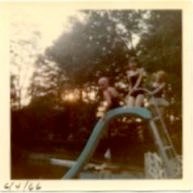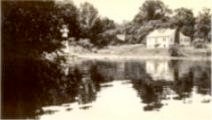History
New City Park
The story of a community
.(Editor note ....This is a copy of a story that ran in The Union Leader, on Wednesday August 18, 1971 by Norreen Schnell. And as time goes on it will be updated. Last updated 10/3/00)New City Park may look like any of hundreds of housing developments in Rockland. But inside the quiet, tree -shaded streets of the community, the story is different.
"The Park", as its residents call it, is more like a private club. Ended much of the community's life centers around the lake and private swim club that has proven to be one of the main attractions of the area.
The story of New City Park goes back to 1926 when Theodore K. Omley. Nils J. Hansen and Reinhard Hall got into a car and drove in the country to find a place where they, their families and friends might spend summers away from the heat and noise of the city.
In those days, Rockland was the country-accessible to the casual tourist only by train, slow bus or long auto ride via Hudson River ferries at 125th Street, Yonkers, or Nyack.
Continued on the History page.
New City Park may look like any of hundreds of housing developments in Rockland. But inside the quiet, tree -shaded streets of the community, the story is different.
"The Park", as its residents call it, is more like a private club. Ended much of the community's life centers around the lake and private swim club that has proven to be one of the main attractions of the area.
The story of New City Park goes back to 1926 when Theodore K. Omley. Nils J. Hansen and Reinhard Hall got into a car and drove in the country to find a place where they, their families and friends might spend summers away from the heat and noise of the city.
In those days, Rockland was the country-accessible to the casual tourist only by train, slow bus or long auto ride via Hudson River ferries at 125th Street, Yonkers, or Nyack.
But the three were determined, and the bounced their car over rutted country roads in Rockland in search of land.
As the party explored various roads in New City, Omley observed a gentleman standing by well in a school yard.
Mr. Omley asked the gentleman, Mr. Clark, if he knew on any available property which would be suitable for developing into a summer vacationing community.
Mr. Clark replied that if they would continue along their present coarse north on Middletown Road (now Little Tor Road) , they would come upon the Collyer Farm. This farm had a mill pond on it which was, in fact, the "old swimming hole" of some of the local residents.
The Pair continued north on Middletown Road past Davies Hotel which was originally one of a pair of homes built by brothers.
Unrecorded history has it that the Blauvelt Brothers built houses exactly alike so that there wives wouldn't quarrel over who had the larger dwelling. The second member of the pair was the present Cropsey home located across the road.
They drove past the Cropsey Farm with its red barn, its corn fields, its country lane, its orchards, and over the wooden bridge. The brook flowing under the bridge fed the mill pond on the Collyer Farm.
The pond was about five hundred feet long with timbered shores, picturesque and peaceful. Located at the north end were two buildings, the saw mill which dated back to the 1800's and and ice house built in the early 1900's.
Some of the senior lifetime residents of the area still remember purchasing ice cut from the frozen waters of New City Park Lake.
The Coyller Farm was purchased by Omly, Hansen and Hall. The legal transaction occurred between Earnest Gibbons, the owner in 1926, and the Corporation of Omley, Hansen and Hall although the farm in a familiar sense retained the Collyer family name. The purchase consisted of 52 acres on which are located several buildings. One was the Coyller farmhouse.
This structure later burned and a new house was erected on the site which in now occupied by Park residents, Mr. and Mrs. William Rhode.
The Coyller barn was converted into a home for Rev. and Mrs. E.M.Anderson in which Mrs. Anderson still resides. (Editors note: The Anderson house was demolished after Mrs. . Andersens death in the mid 80's to make room for new two houses.)
The ice house became the refreshment stand and later the club house and there was one small cottage affectionately known as Mr.Gibbons Tea House.
The task of developing the farm into a summer community began. Long, hard hours of labor slowly shaped the new park.
The Omley family chose the Tea House for their home.
The Hall family chose the property next to the Omley's and the Hansen family selected a homesite on the hill, near the eastern boundary of the farm. The little Tea House became the present attractive home of Mr. and Mrs. Omley, the only surviving members of the corporation.
A survey was made of the land and a map drawn up. Roads were laid out, a well dug to supply the residents with water, pipes were laid along each street designated on the map.
The property was divided into building lots and sold to people who shared the same desire for pleasant summer and the original corporation of Omley, Hansen, and Hall became New City Park, Inc.
Meetings of general membership were held in the Club House, a small cottage located on Park Terrace this has since been converted into a home.
Property was offered to ministers for half-price to encourage the residence of clergy in the community.
An additional twenty acres was purchased from a neighboring land owner Norman Baker, a retired editor of the Nyack Journal. This land was donated to the Park Evangelical Free Church for a building site for the church and a summer conference grounds.
Dredging the lake was a major task. The original mill pond had been dug by the Coyller family with a team of oxen. The founding families of New City Park deepened the lake and raised the dam by two feet, six inches.
It was not all work. Summer offered swimming, and boating. Fishing was a popular summer pass time.
Mrs. Hansen was the first to operate the Club House stand. She was followed by Mrs. Omley who continued for ten years. Refreshments and food were served . In fact, Mrs. Omley recalls serving a special occasion turkey dinner to nine-five people on a porch screened with cheese cloth.
During the depression of 1929, many new City Park members lost their city homes and moved to their summer cottages which they adapted for winter occupancy. This involved further labor, but opened additional avenues of recreation such as skating and sledding and winter scene.
As yearlong living became the mode, people building new houses erected dwellings of a more permanent structural nature ." One of the first of these was the home of Oscar and Anna Larsen, Mr. and Mrs. Wellinder, Capt. Edgar and Esther Raymand, and Capt. Louis and Alice Pedersen.
In the forties, fifties and sixties, Americans of many national origins have been welcomed to New City Park and all are grateful to the originators for having planned a community which still retrains a refreshing rural flavor.(Editor note: at the turn of the century were still hanging on)
Although "The Park" started as a Scandinavian community , residents of nationalities have been welcomed over the years. The attraction, they say, is the rural nature of the community, it's friendliness and charm.
Today 200 families live in "The Park", and seem determinded to carry out the intent of the founders, who set down the objectives in the first annual meeting of the New City Park Club, July 6, 1929,"...The purpose of the club is to promote good fellowship, social activities and the welfare of the community."
Present day officers of the club (which provides actives and maintains the lake seem determined to live up the objective. William Hetherington is president of The. Board of Governors.
Top of page









